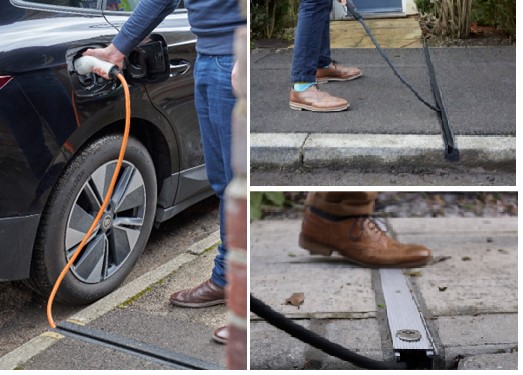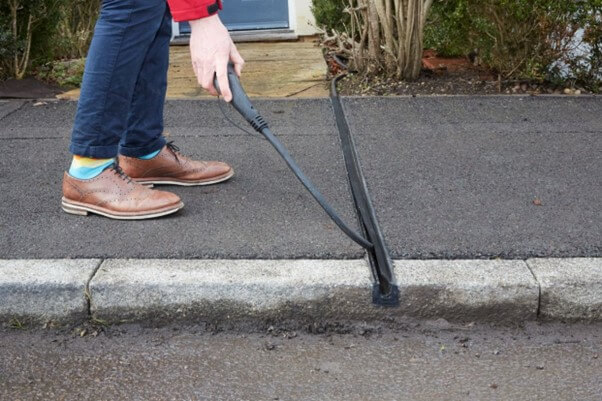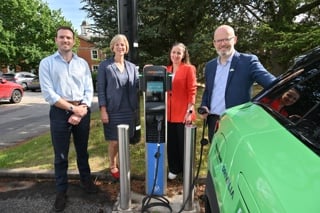New planning guidance has been issued to help local authorities in England develop policies about the safe and effective use of cross-pavement electric vehicle (EV) charging solutions.
It provides information on the areas, regulations and processes to consider when forming policy. It also includes case studies of local authorities that have successfully trialled installations.
Statistics from the English Housing Survey (EHS) estimate that approximately 8 million households (32%) in England do not have access to off-street parking, such as a drive, garage or residential car park.
However, of those, almost 4 million households (16%) have access to ‘adequate on-street parking’, defined in the EHS as ‘street parking generally being available outside or adjacent to the house or block of flats where the surveyed flat is located, and the road is sufficiently wide to allow easy passage of traffic’.
These households could potentially benefit from domestic EV charging safely with the installation of cross-pavement solutions.
In the newly published guidance, the Department for Transport (DfT) says that there are two main types of solution that have been subject to trials and are currently on the market.
Sometimes referred to as ‘gullies’, cable channels embedded within the pavement are designed to temporarily house the charging cable while the vehicle is being charged. The cable is removed once charging is complete.
These are the most common solution used at present, according to the DfT, and trials have taken place in multiple local authorities using various suppliers.

Examples of cable channels or gullies in the pavement
Solutions where a permanent charging cable is laid below the pavement, connecting the domestic charge point via removeable bollards, a lance, or other connectors to the vehicle.
Removable charge point with cable laid under pavement
There are other emerging technologies, such as charging bridges, that are not covered in the guidance.
It also does not cover temporary solutions, such as cable covers or mats, which can be placed on top of a cable. These create a small ramp which can lower pedestrian trip hazards.
The Government says that the decision to permit the installation of a cross-pavement solution rests with the relevant local authority.
Local authorities, it explains, should consider how an installation complements local charging strategies or local transport plans.
Permissions for an installation may sit across different authorities or departments within the same authority.
In England, where there are two tiers of local government, the local transport plan and highways authority will generally sit within the upper tier but planning permission will be at lower tier level.
Local authorities are encouraged to identify and engage with relevant parties (planning departments and EV teams) to understand and co-ordinate the process.
DfT says these solutions are most effective where a resident can park on-street by their property at least once per week.
The installation of a cross-pavement solution does not give the resident ownership or priority to the parking space outside their home, and this should be made clear to the resident, it adds.
A local authority can pre-approve suppliers of cross-pavement solutions or allow residents to seek their own.
For example, Milton Keynes City Council have developed a service for EV cable channels using a specific solution supplier.
The resident pays for the initial survey fee and, if satisfied, the highways team grant permission to install. The resident then pays for a highways-approved contractor to install the channel.
Conditions for use are laid down in a terms of reference document.
The highways team retain maintenance liability for the cable channel, but the resident is responsible for the charge point and cable.
After an initial three-year maintenance period, the homeowner (whether new or existing) may extend permission for the cable channel for an annual fee.
This covers the continued insurance indemnity, routine inspections, any required maintenance and administrative costs.
If the permission is not extended after the three-year period, or annually thereafter, the council may remove the channel and reinstate the footway surface.
For a supplier-owned model, the supplier of the cross-pavement solution retains ownership of the solution.
The supplier is responsible for maintenance and organising the installation once they have received necessary permissions from the local authority.
Maintenance responsibilities should be established as part of the terms of agreement, says DfT. These can vary depending on the terms and conditions and ownership model.
When drawing up responsibilities, DfT says that local authorities should consider breaking down requirements into regular maintenance - removal of leaves or grit in cable channel; and long-term maintenance - cracks or un-levelling.
The Local Electric Vehicle Infrastructure (LEVI) Fund supports local authorities in England to work with industry and transform the availability of charging for drivers without off-street parking.
Local authorities can include cross-pavement solutions in their LEVI capital fund projects where these form a coherent part of local plans, says the DfT.
Cross-pavement solutions supported through LEVI must form the minority of a project. Local authorities are also expected to leverage commercial funding or homeowner contributions to support cross-pavement solutions.
Prior to installation, permissions must be sought from the local highway authority and/or local planning authority, depending on the ownership model.
The local highway authority and local planning authority are responsible for the maintenance and management of highways and public spaces.
As such, they will need to assess any proposal for its impact on traffic, pedestrian safety, accessibility and the surrounding environment.
Who needs to apply for the permissions will be dictated by the ownership model and installer chosen by the local authority. Where the road has not been adopted by the highway authority, the resident should seek permission from the landowner instead.
























Login to comment
Comments
No comments have been made yet.